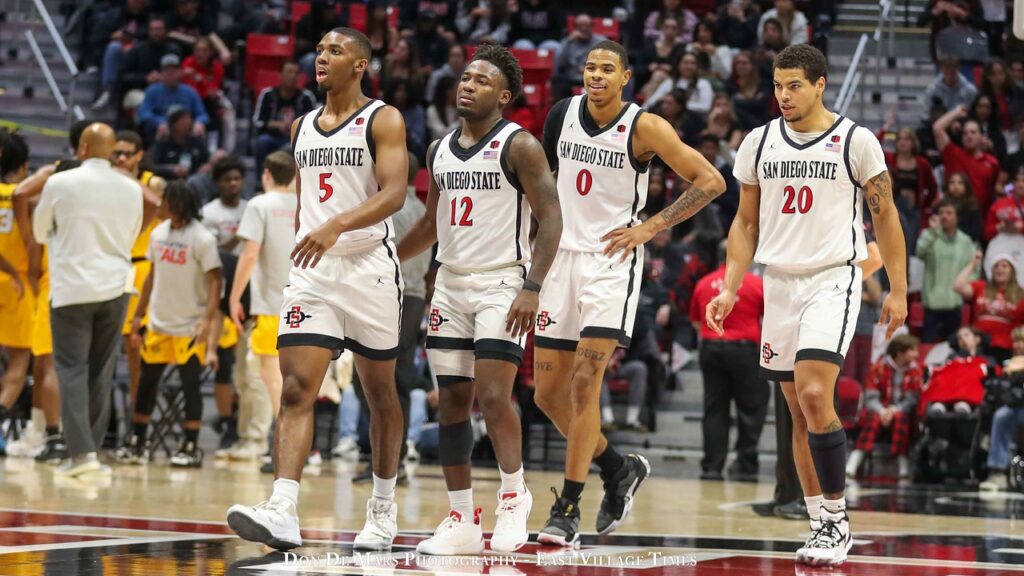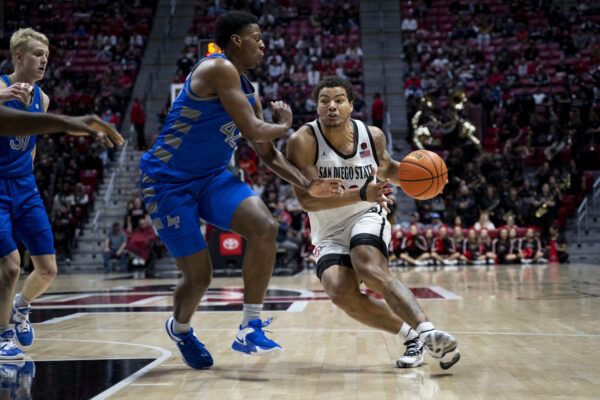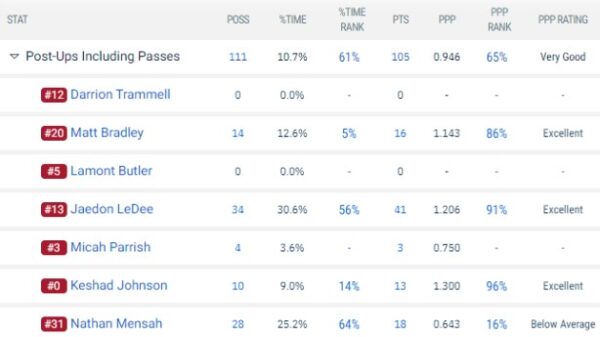Narratives midway through the season

SDSU's final non-conference game is Tuesday against crosstown rival UCSD. Conference play begins at home against Air Force on 12/28. (Don De Mars/EVT)

The Aztecs’ season hasn’t gotten off to the start that everyone hoped for. They dropped two games in Maui and another on a neutral floor to Saint Marys. As of December 30th, they stand at 10-3, with a good win over Ohio State but not much else to speak of. They’re 26th in KenPom, 31st in the NET, and 30th in Strength of Record. At the moment, most bracketologists have SDSU somewhere in the 8–9 range, which is disappointing given the high expectations heading into the season.
Is there reason for optimism? What have we learned about this team so far?
The name of the game is inconsistency:
If there is one word that describes the Aztecs so far, it is “inconsistent.” This team beat a good Ohio State team (16th in the NET, 14th in KenPom) by eleven on a neutral floor. Then a few games later, they needed a last second three pointer to beat UC Irvine (83rd, 104th) and needed a 15-2 run in the second half to beat Troy (120th, 140th) at home by five. They played really well against Arkansas until they gave up a four-point lead in the last seventeen seconds of regulation.
In their thirteen games played, they have four where they’ve shot 20% or worse from behind the arc and four where they’ve shot 44% or better from three. The league average is 33.4%.
The inconsistency can be seen with individual players too. Matt Bradley, for example, just dropped 27 points against Air Force on 75% shooting from the floor, including 6-7 from deep. Before anyone thinks, “Well yeah, it’s Air Force,” remember that Air Force is a top 10 team in terms of 3-point defense. Also, Bradley also only had 9 points against D-III Occidental and a meager 4 points on 29% shooting against Kennesaw State. The guy that dropped 23 points against the 7th best defense in the nation (Arkansas) also had only 8 points on 29% shooting against Cal St. Fullerton.
Last season Bradley had six games where he scored in single digits, and two of those were in the conference tournament at the end of the season. This year, he already has seven. Bradley was among the favorites for Mountain West player of the year in the preseason. He’s shown flashes that he can still be that guy but needs to find consistency.

To his credit, Bradley has scored 50 points in two conference games and won Mountain West Player of the Week. If he can maintain that, the Aztecs offense will be much improved. If the inconsistency remains and he regresses, it could spell problems for the team.
Bradley isn’t the only one, either. Losing a game never comes down to only one player, but if ever a game did, the loss against Arkansas would fall on Lamont Butler. He made a mistake and decided to foul while his team was leading by 4 with 13 seconds left. Arkansas hit both free throws. Then they trapped Butler on the inbound and forced a turnover. The rest is history.
There is no guarantee that if Butler doesn’t foul, the Aztecs win, but it would’ve helped a lot. It was probably the worst stretch of Butler’s career. Human’s tendency towards negativity bias means those two possessions will shape the season for many. Since that game, Butler hasn’t been seeing the floor in end-of-game situations as much. Despite that, he leads the team in +/-, as the Aztecs have outscored their opponents by 92 when Butler has been on the floor. The next closest player is Darrion Trammel, who has a +/- of 93 despite playing almost one hundred more possessions. Butler had the worst moments of his career in the middle of what has objectively been his best season so far.
Almost every player could be mentioned here, but the last one will be Jaedon LeDee. Early on, he looked like the world-beater Aztec fans were promised. In his first three games, he was averaging 16 points and 5 rebounds in 22 minutes a game. Since then, he’s averaging 5 points and 5 rebounds in 17 minutes per game. He’s shown flashes still. He had 12 rebounds against UC San Diego; he had 14 points against Kennesaw State (mostly due to his 11 trips to the free throw line.) He largely still looks like a player struggling to find his consistency.
Overall, it still seems like the team has yet to put together a full 40-minute game. When they do, they have a lot of potential, but there’s no guarantee they ever find that rhythm.
Reasons for optimism: Habits are starting to take hold
One potential cause for the inconsistency is a bunch of players being in new roles. Both Matt Bradley and Darrion Trammell are used to having the ball in their hands and being the primary shot takers on their teams. Both of their shot attempts are down compared to last season so far. After a win against UCSD, when asked about the difference in scoring each half, Trammell said, “That’s definitely been the biggest thing for me, just letting the game come to me. I’m playing with a lot of great players. ‘If you play the right way, the ball is going to find you.’ That’s coach Dutch’s saying. I’ve been living up to that and letting the ball find me and doing my best.”
The habits they each have can hurt the offensive flow as well. Bradley too often turns down open looks in favor of dribbling the ball to create for himself because he’s not used to having others create for him.
This looks like an open shot to me. Trammell did his job to break the defense. Bradley needs to capitalize and take the shot. He pulled it down and later Butler took a contested 3. pic.twitter.com/DxNjGBW99M
— Aztec Breakdown (@aztecbreakdown) November 26, 2022
Bradley has been much more efficient in catch-and-shoot situations, but he doesn’t have those habits built up. His most used play type at Cal was as the pick-and-roll ball handler, and last season he often had the ball in his hands to run isolation sets. He’s played off-ball before, but never quite this much. Changing those habits is a process that could contribute to the inconsistency.
For context, Bradley scores 1.111 points per possession on catch and shoot plays, and only 0.915 on jump shots off the dribble so far this season. https://t.co/o2DRkDuMlq
— Aztec Breakdown (@aztecbreakdown) December 30, 2022
Trammell, on the other hand, will often force shots he shouldn’t, as he’s used to shooting from deep anytime the defending big is in a drop coverage. He’s a good scorer, but the thing he does that no one else can do at his level is facilitate. His goal should be to pass to an open teammate every play and then shoot the ball when the defense stays home on everyone else. It is something he has the talent to do, but once again, he hasn’t built up those habits as much yet.
This is a “pass up a good look for a great look” situation. Mensah very smartly flips the screen, Trammell sees the big drop and pulls. I’d argue he should collapse the defense more though. That shot is what the defense is hoping for. pic.twitter.com/PC9e77j2sY
— Aztec Breakdown (@aztecbreakdown) December 31, 2022
Micah Parrish was a starter last season for Oakland and is now relegated to being a 3&D role player off the bench. It’s a different role for him, and while he has the talent for it, he doesn’t have the habits yet—things like when to screen, when to cut, when to shoot and not shoot.
Adam Seiko, on the other hand, is in the same essential role he’s always been in and has been playing very well. He hasn’t been a world-beater, but he’s done what he’s supposed to do. He plays good defense and stretches the floor offensively.
I swear it seems like Seiko makes this shot every time. Well designed play to run him off of 3 screens. pic.twitter.com/BkOKCKhyj5
— Aztec Breakdown (@aztecbreakdown) December 16, 2022
The good news is as the season progresses, the players will get more time to learn how to play with each other. Coach Dutcher’s teams tend to improve as the season goes on, so there is reason to believe that will happen again this season. The defense has already started to improve after an uncharacteristic start.
Are there more concrete solutions besides “time will fix this team?”
Yes. It’s always a process. Some habitual adjustments have already been mentioned. Having Bradley catch and shoot more is one solution that will help the offense. Having Trammell probe defenses more should help as well. Encouraging players to drive the hoop rather than pull up from deep in transition could be very beneficial.
Trying to go over some tape. This is the kind of thing that drives me crazy, even when someone like Schakel would do it I rarely liked it. Taking a deep contested 3 in transition defeats the whole purpose of running in the first place. pic.twitter.com/kx3MZhW4GK
— Aztec Breakdown (@aztecbreakdown) December 11, 2022
Those are all changes that can be made by going over them in the film room and encouraging players to play slightly differently. It’s not such a drastic change as telling Trammell to never shoot pull-up jumpers, or telling Bradley to never isolate, just to encourage them to do other things a little more.

The coaches need to go through the process of figuring out who can be trusted in which roles. One negative side effect of the touch non conference schedule is that the team hasn’t been able to experiment with new things to see what works as much.
After the UCSD game, Coach Dutcher said, “When you’re ahead by 15, 16, 18 points, you’re going to see what these other guys can do. When they show you what they can’t do, now you can come back and say, ‘this is not a good idea for you to be trying this.’ Sometimes, you have to let them fail in order to teach them.”
A scheme change isn’t going to happen at this point. Installing a new offense halfway through a season isn’t going to go well. A few new plays can maybe be installed, but not much else. So helping player habits is the way to go.
Deployment of players within the scheme may be helpful, however. For example, getting guys like LeDee and Bradley more touches in the post may be beneficial. They’ve both been among the elite scorers down low this season, especially when adding passes from the post.

The other thing that can help is figuring out which lineups are best and using them as much as possible. Despite the cliche being “it’s not who starts, it’s who finishes,” the starting lineup very much matters. The starting lineup plays about three times as many possessions as the next most used lineup, so they’re on the floor more than anyone else is together. Which means that the starting lineup has the greatest impact on whether the team wins a game or not.
For example, the current starting lineup of Trammell, Butler, Bradley, K. Johnson, and Mensah has played 151 possessions together. The next closest lineup, which only switches out Mensah for LeDee, has played a mere 42.

The good news is it seems the Aztecs may have found their best starting lineup. The chart shows better lineups but none that should be expected to keep their crazy efficiency when given more time.
After that, it’s a matter of figuring out how to distribute minutes and who should be on the floor together as much as possible. For example, it has been proposed by many (including myself) that LeDee should play more power forward next to Mensah. However, early results suggest that they are the last players that should play with each other; as to this point, they actively make each other worse on the floor.

The numbers so far show that LeDee’s best partner is Keshad Johnson, while Mensah’s is Aguek Arop. That doesn’t work out well with the starting lineup being what it is, but if the coaches can try and get those pairings as much as possible, it will help the team out.
Other things the coaches can try include: playing Micah Parrish at the power forward spot in spurts to help spacing or playing Matt Bradley at the shooting guard spot more to get him against smaller defenders and get him going offensively. Combining that with getting Ledee and Bradley post touches could form a very dangerous small ball lineup. Surround LeDee and Bradley with shooters like Trammell, Seiko, and Parrish for a few minutes each game, and the offense might really get going.
One thing that has already started to improve is the team’s transition offense. For the first ten games, the team had a better half-court offense than transition offense, which is very hard to do. Their transition offense has started to improve, though. It is still bad relative to other teams’ transition offenses, but it is now more efficient than the half-court offense, so that counts as improvement.

[wpedon id=”49075″ align=”right”]
Summary:
While the season hasn’t started off as fast as fans would’ve hoped, the Aztecs are in a solid position. The team has shown both their best and worst sides so far this season, but there are reasons to believe that they can improve. They have shown the talent, they just need to define the roles and build the habits. If they do that, they will be able to meet the expectations they came into the season with.
Native San Diegan living in Montana. Big time Aztec Basketball fan. Creator of Aztec Breakdown. Hoping to help people enjoy basketball more by increasing their understanding of it.